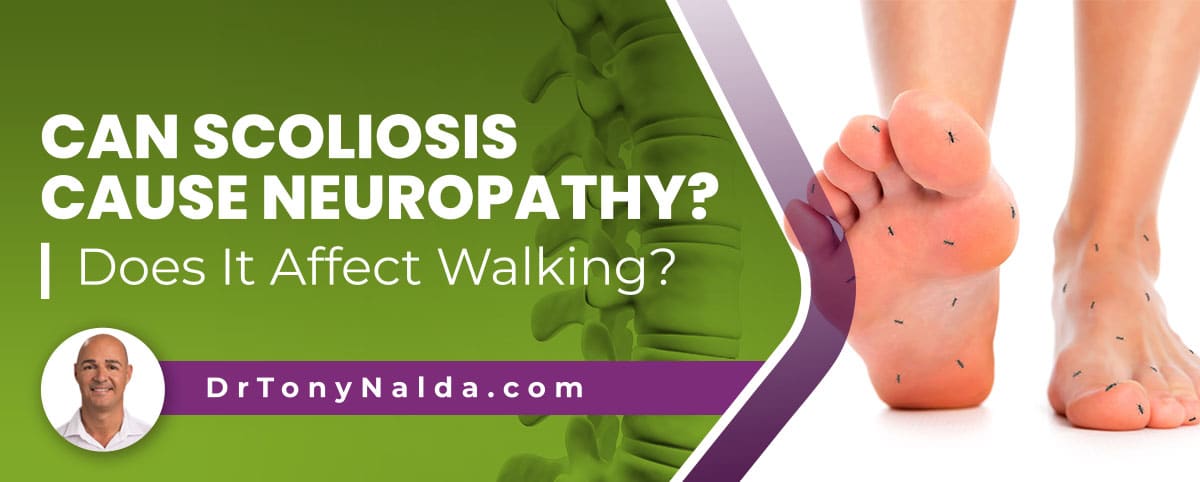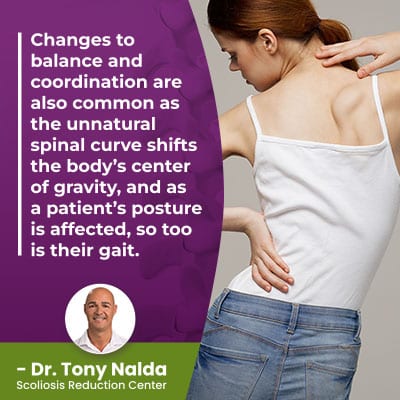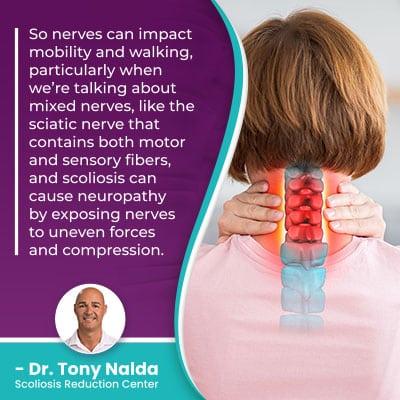Can Scoliosis Cause Neuropathy? Does It Affect Walking?

Scoliosis can cause a number of symptoms felt throughout the body, and patient age and condition severity are significant factors that shape the type of scoliosis-experience a patient is likely to have. Scoliosis introduces a lot of uneven forces to the body that can disrupt its overall symmetry, causing changes to balance, coordination, and gait.
Scoliosis involves the development of an unnatural spinal curve, and if a spinal nerve is compressed, it can become damaged: neuropathy. Scoliosis can affect walking not only because of nerve damage, but also because of postural changes that can disrupt a patient’s balance and gait.
So let’s start with what a diagnosis of scoliosis means, and how the condition can affect the body.
Table of Contents
Understanding Scoliosis
When a person is diagnosed with scoliosis, they have developed an unnatural sideways spinal curve that also twists (rotates), and this is what makes the condition 3-dimensional.
 Scoliosis is also progressive, meaning it has it in its nature to worsen over time, and this means that scoliosis isn’t a static condition; it’s always changing, and only proactive treatment can work towards counteracting the condition’s progressive nature.
Scoliosis is also progressive, meaning it has it in its nature to worsen over time, and this means that scoliosis isn’t a static condition; it’s always changing, and only proactive treatment can work towards counteracting the condition’s progressive nature.
Scoliosis progressing means the size of the unnatural spinal curve is also increasing, and this means so too are the condition’s uneven forces, and their effects.
There are never treatment guarantees, but with scoliosis that’s detected early and addressed proactively, there are fewer limits to what can be achieved, and different treatment approaches can affect long-term spinal health and function differently.
When we’re talking about surgical scoliosis treatment, a risk associated with spinal fusion is nerve damage, while conservative treatment doesn’t carry that risk as it uses a less-invasive chiropractic-centered treatment approach.
When it comes to understanding the effects of scoliosis, there are a lot of factors that shape a patient’s experience of life with scoliosis, and when it comes to symptoms, condition severity and patient age are significant.
Understanding Scoliosis Effects
Part of the reason scoliosis is a complex condition to treat is because it affects all ages, has multiple types and severity levels, and its nature is progressive, so it’s virtually guaranteed to get worse at some point.
When scoliosis is first diagnosed, part of the process involves comprehensively assessing conditions to further classify them based on key patient/condition variables, and these variables shape the customization of treatment plans.
Condition severity is a key classification point, and this is determined by a patient’s Cobb angle measurement, and this piece of information is needed to diagnose, assess, and determine condition severity.
The more severe a condition, the more out of alignment the scoliotic spine is, and the more tilted the vertebrae are at the curve’s apex:
- Mild scoliosis: Cobb angle measurement of between 10 and 25 degrees
- Moderate scoliosis: Cobb angle measurement of between 25 and 40 degrees
- Severe scoliosis: Cobb angle measurement of 40+ degrees
- Very-severe scoliosis: Cobb angle measurement of 80+ degrees
The more severe a condition is, the more likely it is to cause noticeable effects, one of which can be nerve pain and damage; the main effect in children is postural deviation, and in adults, it’s pain.
Scoliosis pain in adults can take the form of back pain or radicular pain that’s felt in the body’s extremities; nerve pain is the main reason adults come in to see me for a diagnosis and treatment.
The more severe a condition, the more its uneven forces are going to interrupt the body’s overall symmetry.
Scoliosis and Neuropathy
There are 31 pairs of spinal nerves that exit the spinal cord and branch out to different areas of the body, so many spinal conditions are associated with neuropathy, scoliosis included.
 When the spine is curved unnaturally, this can mean exposing its nerves within, or where they branch out, to uneven pressure (compression), and this can cause an affected nerve(s) to become irritated, inflamed, and/or impinged, and this can cause neurologic dysfunction: when nerves can’t function optimally.
When the spine is curved unnaturally, this can mean exposing its nerves within, or where they branch out, to uneven pressure (compression), and this can cause an affected nerve(s) to become irritated, inflamed, and/or impinged, and this can cause neurologic dysfunction: when nerves can’t function optimally.
Remember, nerves are like branches of a tree, fanning off in multiple directions, and this is why nerve damage can cause symptoms felt far from the damaged nerve and site of origin; this can make nerve-related issues difficult to diagnose.
The role of the central nervous system is to send and receive signals to and from the brain, and these signals can involve sensory and/or motor functions, and the nerves also direct blood throughout the body and to its muscles.
Remember, the spine and spinal cord together form the central nervous system, so if the unnaturally-curved spine is compressing a nerve in the lower back, for example, this can cause issues with lower-back and lower-body mobility and pain.
When it comes to walking, nerve compression can affect mobility as it can cause muscle weakness, and once scoliosis becomes a compressive condition in adulthood, conditions are far more likely to also be painful.
Prior to reaching skeletal maturity, the constant lengthening motion of a growing spine counteracts the compressive force of the unnatural spinal curve, which is why scoliosis isn’t commonly described as painful by young patients.
So nerves can impact mobility and walking, particularly when we’re talking about mixed nerves, like the sciatic nerve that contains both motor and sensory fibers, and scoliosis can cause neuropathy by exposing nerves to uneven forces and compression.
Scoliosis and Changes to Gait
So scoliosis can cause neuropathy by causing nerve compression that can cause pain that makes it difficult to walk, and when nerves are compressed, that can also affect blood flow to muscles, and poor muscle strength and function can also factor into changes to gait, along with related a muscle imbalance that can be associated with scoliosis.
The main way in which scoliosis can affect walking is through postural changes the condition is associated with.
I mentioned earlier that there are different types of scoliosis, and the most prevalent type is adolescent idiopathic scoliosis, diagnosed between the ages of 10 and 18, and this age group is that most at risk for rapid-phase progression; growth is the condition’s trigger for progression, so adolescents in, or entering into, the stage of puberty can seem to progress overnight.
As the condition introduces uneven forces to the body, those forces can disrupt the body’s overall symmetry, and its main effect is postural deviation.
In children, the condition can be difficult to detect because it’s not yet compressive, and when mild, the postural changes can also be mild.
Oftentimes, the earliest signs of scoliosis in children are uneven shoulders and hips, and in addition, the development of a rib arch, an uneven waistline, and arms and legs that appear to hang at different lengths.
An additional sign to watch for is clothing suddenly seeming ill-fitting, arms and legs hanging unevenly, necklines seeming stretched and pulling noticeably to one side.
Changes to balance and coordination are also common as the unnatural spinal curve shifts the body’s center of gravity, and as a patient’s posture is affected, so too is their gait.
In fact, if I’m screening for scoliosis, in addition to taking the patient’s family/medical history, performing an Adam’s forward bend test and observing the patient’s posture, I can learn a lot about a patient’s spine by how they walk.
Remember, a scoliotic spine doesn’t just bend unnaturally to the side, but also twists, and this type of abnormal spinal curvature is known to affect how a person walks.
Conclusion
Scoliosis is a structural spinal condition, but its effects aren’t just isolated to the spine, and neuropathy is a potential effect.
Nerve compression is common in scoliosis, particularly when severe and/or once skeletal maturity has been reached; once patients reach skeletal maturity, the condition becomes compressive, which is why scoliosis is painful for adults, but not commonly for children.
Neuropathy means a nerve is damaged, and once a certain degree of nerve damage has occurred, it can be difficult, if not impossible, to reverse; preventing irreparable nerve damage is another benefit of being proactive with scoliosis treatment.
Scoliosis can affect walking in a number of ways; if the condition is causing noticeable back pain, standing upright for long periods of time, and walking for long periods of time, can be challenging.
Scoliosis can also affect a person’s gait by changing their posture as it shifts their center of gravity, also disrupting balance and coordination.
Scoliosis can also affect walking through nerve compression and neuropathy; if a nerve is damaged, its ability to transmit signals and transport blood, throughout the body, including to its muscles, can be impaired.
Here at the Scoliosis Reduction Center, I help minimize the effects of scoliosis, including disruptions to posture, balance, and gait through proactive treatment that addresses the underlying structural nature of scoliosis.
Dr. Tony Nalda
DOCTOR OF CHIROPRACTIC
After receiving an undergraduate degree in psychology and his Doctorate of Chiropractic from Life University, Dr. Nalda settled in Celebration, Florida and proceeded to build one of Central Florida’s most successful chiropractic clinics.
His experience with patients suffering from scoliosis, and the confusion and frustration they faced, led him to seek a specialty in scoliosis care. In 2006 he completed his Intensive Care Certification from CLEAR Institute, a leading scoliosis educational and certification center.
About Dr. Tony Nalda
 Ready to explore scoliosis treatment? Contact Us Now
Ready to explore scoliosis treatment? Contact Us Now





